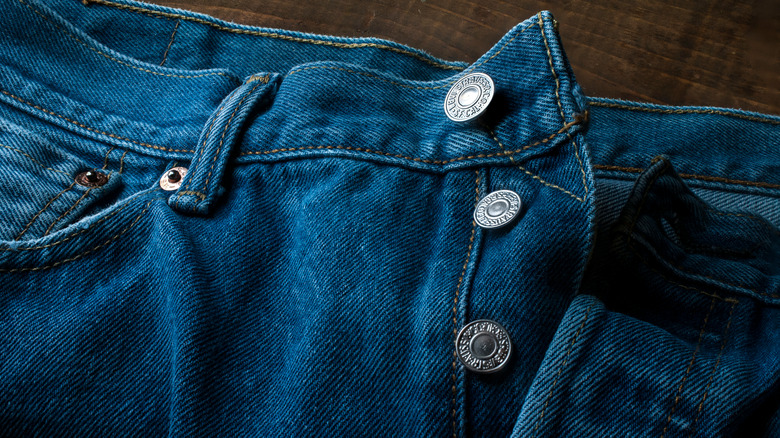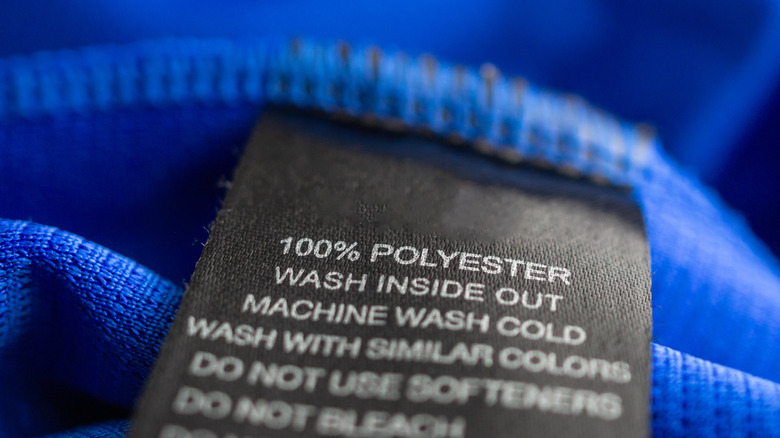Tips For Intentionally Shrinking Clothes For A Better Fit
Besides following the care instructions on our clothing, sometimes our bodies or needs change after we've already purchased an item, and we're looking for new hacks to help our clothes keep up with our lifestyles. Materials may react differently to heat and cold, and there are also terms to familiarize ourselves with to better understand our clothing.
Patric Richardson, a Minneapolis-based laundry expert, told Apartment Therapy about one hack to get more room in your too small clothes: mix a spoonful of conditioner in with warm water, soak for 30 minutes, then stretch the item, rinse, and air dry. He explained, "When you throw your shirt in the dryer and it shrinks, what's happening is the fibers are tightening on top of themselves like a dreadlock. The conditioner allows them to loosen so you can manually manipulate it back out. It's like detangling with a conditioner."
However, it's also fun to go the other way when it comes to resizing our clothes. As Madeline Aaronson, brand director for thredUP, told Martha Stewart, "Buying something oversized can be a fun way to experiment with your style, and depending on the fabric, you might be able to shrink it or [DIY to] your liking." But what's the best technique for shrinking clothes to more flattering shapes on our bodies?
Cotton is the most straightforward
Treatments to re-size our clothing vary based on the science of the material at hand. HGTV recommends against using your dryer's sensing tech to decide when your cotton clothing item is done shrinking. Instead, try 60 minutes, or check on your item regularly and remove it from high heat when it's the size you want, even if it isn't completely dry. Another method is boiling water and adding a piece of cotton clothing for five minutes, then putting it in the dryer on high heat until it is totally dry.
You should use caution when shrinking cotton shirts, because there is the chance that super high heat could damage your clothing's designs. Turning a shirt inside out, as well as washing it with like colors, might save it from some stress.
Old Bull Lee's founder Lee W. Johnson shared with InStyle, "It is to be assumed that a shirt will shrink more in length than width," explaining that materials shrink by percentages. Johnson lumps denim, polyester, and cotton together as pieces that can be washed with hot water and dried in high heat. He told readers, "Keep checking on the garment and remove once you're happy with the size — remove and air dry." However, each kind of material does best under different conditions.
Denim is workable
Denim is a kind of magical material that we want to wear in just right to achieve its full cool-factor. But even the best-laid plans can go awry, and we may need to work a bit harder for our custom fit than just refraining from washing our jeans. To shrink a full piece, you can submerge it in boiling water for 30 minutes, then let it cool and drain in a colander before drying on high heat. Though, you may only need to go after one area of your jeans that's gotten saggy; in this case, all you need is to spray that section with water and flat iron out the moisture.
However, Mary Gagliardi told Readers' Digest, "Not all denim reliably shrinks in more than the width." So, it may be best not to get your hopes up for getting those too-long pants perfectly tailored to you — you may just need to start cuffing the hems.
Polyester presents some challenges
Synthetic fabrics like polyester and nylon aren't as likely to shrink as organic fabrics, though Mary Gagliardi shared with Readers' Digest, "Machine washing and drying could cause some shrinkage in the length." For polyester, you may be able to repeat the same hot water wash and high heat drying process you used on your cotton items; but don't be surprised if it takes a few goes to get the result you're looking for. You may also want to be careful that you aren't prematurely aging your material and leaving your clothes looking worn out. For example, shrinking because of consolidation is when aggressive movements during drying cause some fibers to grow closer together while discarding other fibers as lint.
Daniel Fitzgerald of CD One Price Cleaners told Martha Stewart, "Fabrics that include Lycra, Spandex, etcetera, specifically have an elastic/stretching element to counteract shrinkage." He added, "Some types of garments will shrink more, but manufacturers tend to avoid producing shrink-prone items because customers usually don't like them." Contraction can shrink clothing by absorbing the material's inherent moisture, which is why more moisture-dense fabrics like wool tend to shrink more easily than synthetic materials.
Organic fibers are a different story
Warm water is best for shrinking wool, and HGTV recommends placing your item in a bag during the wash to avoid damage to the material. Drying in low heat for 30 minutes, and checking on the item's progress shrinking is the way to see the best results. If you only want to shrink portions of the piece, you can use warm water in spots and a hairdryer.
If you don't take the proper steps for wool and just assume it will shrink the way your other items do, you may just be causing "felting." Mary Gagliardi explained to Readers' Digest, "When a wool sweater that has not been treated to prevent this is machine washed and dried, it looks noticeably smaller. But it hasn't shrunk, it has felted." So, for items made of wool or cashmere, the expert warns against tampering with their size. She shared, "You cannot unlock the fibers once they lock together, and the overall appearance is different—the garment doesn't just get smaller, the surface is matted and the fabric loses its stretch."
Silk is another organic fiber that can shrink easily when exposed to heat. A simple method is using warm water, inserting your clothing item, and stirring over the course of a few hours. Another method is using boiling water, but quickly removing the pot from heat while stirring the item. However, like with wool, experts tend to advise against shrinking silk, since it is likely to damage the piece's integrity.




